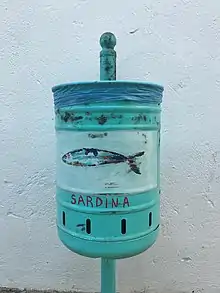Waste container
A waste container is a container for temporarily storing waste, and is usually made out of metal or plastic. Some common terms are dustbin,[1] garbage can, and trash can. The words "rubbish", "basket" and "bin" are more common in British English usage; "trash" and "can" are more common in American English usage. "Garbage" may refer to food waste specifically (when distinguished from "trash") or to municipal solid waste in general. In 1875, the first household rubbish bins were introduced in Britain to create a regulated system of collection.


Public waste collection
In many cities and towns, there is a public waste collection service which regularly collects household waste from outside buildings etc. This will be loaded into a garbage truck and driven to a landfill, incinerator or crush facility to be disposed of. Household waste containers are usually either:
- trash cans, receptacles made of metal or plastic
- wheelie bins, light, mobile plastic bins
In some areas, each household has multiple bins for different categories of rubbish (usually represented by colours) depending on its suitability for recycling, which will instead be routed to a recycling center.[2]
Commercial roadside waste containers are often larger dumpsters or skips.
Public litter bins



Public areas such as parks, often have litter bins placed to improve the social environment by encouraging people not to litter. Such bins in outdoor locations or other busy public areas are usually mounted to the ground or wall to discourage theft, and reduce vandalism, and to improve their appearance are sometimes deliberately artistic or cute. In dense urban areas, trash is stored underground below the receptacle.[3] Many are lined with a plastic or paper bin bag to help contain liquids.
Designs

A pedal bin is a container with a lid operated by a foot pedal. Lillian Moller Gilbreth, an industrial engineer and efficiency expert,[4] invented the pedal bin in the 1920s for the disposal of kitchen waste. The foot pedal enables the user to open the lid without touching it with their hands.
In the 2010s, some bins have begun to include automated mechanisms such as a lid with infrared detection on the top of the can powered by batteries to open it rather than a foot pedal, freeing the user from touching the bin in any way. Some bin models also include a small receptable for an air freshener.
Metaphors

The term "garbage can" is also used for a model of decision making, the "Garbage Can Model" of decision making. It is concerned with cases of decision making in great aggregate uncertainty which can cause decisions to arise that from a distant point of view might seem irrational.
A "trash can" metaphor is often used in computer operating system desktop environments as a place files can be moved for deletion.
In a workplace setting, a bin may be euphemistically called "the circular file", "the round file" or "the janitor's file". Whereas useful documents are filed in a filing cabinet, which is rectangular, junk mail and other worthless items are "filed" in the bin, which is often round.
The term "waste basket" is occasionally used in taxonomy to refer to groupings that are based on some non-genetic criterion (e.g., the proposed order Insectivora is considered a "wastebasket taxon", as it groups small mammals whose chief link is that they eat insects), and the Nilo-Saharan language family is sometimes called "Greenberg's wastebasket", as it was a grouping made by him to fit the languages of Africa that did not fall into the other groups, Afroasiatic, Niger–Congo, and Khoisan.
See also
References
- Government of Hong Kong. "Civil Service Bureau".
- "Rubbish and recycling" Archived 2016-06-12 at the Wayback Machine, ccc.govt.nz
- Shendruk, Amanada (5 August 2018). "Could NYC solve its trash problem with underground trash cans?". Quartz (publication). Retrieved 5 September 2018.
- Mary Ellen Snodgrass (2004), Encyclopedia of Kitchen History, Taylor & Francis, p. 423, ISBN 978-1-57958-380-4
- American Public Transportation Association (2008-09-26). "Recommended Practice for Trash/Recycling Container Placement to Mitigate the Effects of an Explosive Event" (PDF). Retrieved 2014-09-15.
External links
 Media related to Trash container at Wikimedia Commons
Media related to Trash container at Wikimedia Commons- Example of Waste Design for Recycling in Public Spaces